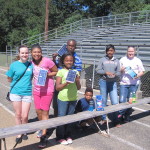 The new school year is in full swing. Excitement and curiosity fills the atmosphere for the children and teens enrolled in the Rural Robotics Program at Mt. Olive Ministries. Each week, the students examine scientific techniques in solar mechanics and civil engineering. Within the semester, two projects are completed by each class of students.
The new school year is in full swing. Excitement and curiosity fills the atmosphere for the children and teens enrolled in the Rural Robotics Program at Mt. Olive Ministries. Each week, the students examine scientific techniques in solar mechanics and civil engineering. Within the semester, two projects are completed by each class of students.
Each class is lectured on the design and function of the upcoming hands-on experiment. Before the actual hands-on approach begins, each child must fully understand the importance of safety procedures in the laboratory.
When asked why safety is important, Joseph Crouse, age 11, of Brandon, MS, replied, “Following the rules protects everyone. It keeps mistakes from happening.”
The first project was to build a solar-powered, model car built on wooden frames. Through instruction from Mr. Ray Holt, each student gained an understanding of the effects of solar energy converted to electrical energy and ultimately transferred into mechanical energy. Volunteers from the senior robotics class assisted the children in the construction of their cars. Alana Peden, 16, and Antawn Easterling, 17, both of Mt. Olive shared their knowledge with the students. A small motor with lead wires, wheels, and a solar panel were attached to the frame. The students performed several troubleshooting test phases before the final race. Upon completion, the cars were judged for speed, appearance and functionality.
Caine Smith, age 9, of Magee, MS, stated, “I enjoyed gluing the wheels on my car. My car will run super fast. I’m expecting to win the race!”
The fastest solar powered car traveled a distance of 200 feet within 5.69 seconds. The cars were also equipped with a battery component. The fastest battery powered car traveled a distance of 200 feet within 6.58 seconds.
The second project was to design and develop a bridge from toothpicks. Mr. Billy Blain, Civil Engineer, along with Mr. Richard Dukette, Instructor of Mechanical Systems, explained the necessary theories in statics. First, each student evaluated the strength of the available materials. The student then applied the knowledge taught in lecture to design a plan. Drawings of the bridge design were submitted to the instructors for approval. Upon completion of construction, each student tested the strength of their bridge by applying hanging weights until the bridge failed. The students produced bridges that held weights up to 41 pounds.
Points are earned for each completed project. As a student reaches 1,000 points, they are eligible to join the competition club. The competition club challenges each student. The students learn how to build and program a robot. The robot’s function is to complete specific obstacles in a set course. The students learn valuable problem solving skills throughout this process. Students compete in state and national competitions. Scholarship money is available to the winners.
Kaitlynn Tuggle, age 13, from Mendenhall, MS, will compete in this year’s competition.
“My goal is to accomplish my project, win an award and most importantly, have fun,” says Kaitlynn.
The completion of the project produces feelings of accomplishment for each student. Confidence is a key to success. The volunteers and supporters of the Rural Robotics Program are providing an atmosphere of learning, teamwork and confidence for future leaders.
